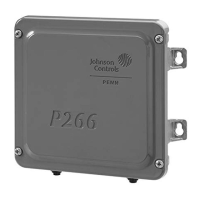P266 Series Single-Phase Condenser Fan Speed Controls Installation Instructions 11
9. At 40% of maximum voltage, use the clamp-on
ampere meter to check the current draw (in
amperes) of the fan motor auxiliary windings
connected to both capacitors, and record the
current draw for the auxiliary winding at 40%
voltage.
10. Repeat Step 7 but increase the percent voltage
value by 8%, then repeat Step 8, Step 9, and
Step 10 at the increased voltage values until the
current draw equals the (maximum voltage) current
draw recorded in Step 4.
Note: If the motor stops or does not run smoothly,
reduce the voltage value on the DIP switches by 4%
and test the motor operation.
11. The DIP switch voltage value is now equal to the
highest voltage of the low-speed mode or the
changeover voltage value.
12. Press and hold the push button until the LED
flashes 3 times, then release the push button. The
changeover voltage value is set and saved on the
P266 Series Control.
Note: If you want to also determine and set the start
voltage value for your P266 Series Control and motor,
you can go directly to Step 3 of the Determining the
Start Voltage Value procedure.
13. Disconnect power to the P266 Series Control and
set all of the DIP switches to the on position to lock
out the push button operation.
14. Reconnect power to the P266 Series Control to
resume normal motor speed control.
Determining the Start Voltage Value
In the test voltage mode, you can also determine and
set the start voltage value for the P266 Series Control
application.
To determine and set the start voltage value:
1. Mount, wire, and set up the P266 Series Control
and the condenser fan motor for operation in the
Test Voltage mode. See Setting Up the Test
Voltage Mode.
Note: If your application uses split winding mode and
low-speed capacitor mode, wire the split windings and
low-speed capacitor according to your application
requirements.
2. Apply line voltage power to the P266 Series
Control (and the external 24 VAC power supply on
required models), then within the first 30 seconds
after applying power, press and release the push
button three times. The LED goes off and stays off.
3. Position the DIP switches so that the total value of
the switches positioned on is equal to a percentage
value equal to or slightly higher than your
estimated start voltage value. (For example, if you
estimate the start voltage of the motor to be 25% of
the total voltage, position switches 16, 8, 4, and 2
to on. 16 + 8 + 4 + 2 = 30%, which is slightly higher
than your 25% estimate.) The fan motor
accelerates to the speed at 30% of maximum
voltage and stays at that speed.
4. Observe the fan motor operation and determine if
the applied start voltage runs the motor at the
desired start speed:
• If the start speed and motor operation meet
your application requirements, go to Step 5.
• If the start speed or operation does not meet
your application requirements, return to Step 3
and set a new estimated start voltage value to
generate the desired motor start speed.
5. When your motor is running at the desired start
speed (start voltage value), press and hold the
push button until the LED flashes 2 times in
succession, then release the push button. The start
voltage value is set and saved on the P266 Series
Control.
6. Disconnect power to the P266 Series Control and
set all of the DIP switches to the on position to lock
out the push button operation.
7. Reconnect power to the P266 Series Control to
resume normal motor speed control.

